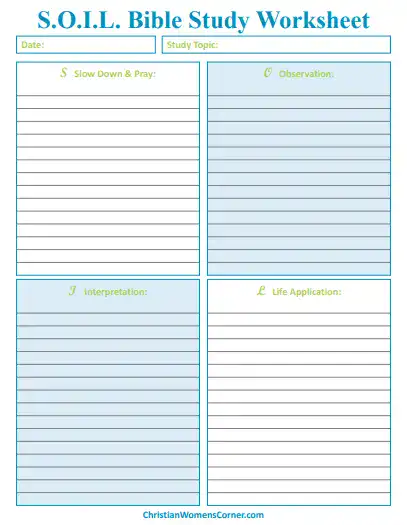An Introduction to the Inductive Bible Study Method
The inductive Bible study method is an investigative way of studying the Bible. It helps provide an overall understanding of a passage of Scripture: what it says, the intended meaning to the original audience, and how it can be applied today.
The inductive Bible study method will help you to:
- Process, understand, and remember the Biblical texts you read.
- Understand the main idea of a passage and concisely communicate it.
- Finally, be able to apply Scripture to everyday living.
Inductive Bible study always includes the following components:
- Observation
- Interpretation
- Application

We will begin by explaining the S.O.I.L. acronym:
S – Slow Down & Pray
This is the first and most essential step in the SOIL Bible Study
Method because it sets the tone for everything that follows. Before we dive into reading,
observing, interpreting, or applying Scripture, we pause. We quiet our hearts, take a
deep breath, and invite God to lead the process. This moment of slowing down is a way
of resisting the rush and noise of everyday life and intentionally creating space for the
Holy Spirit to work. It reminds us that Bible study isn’t just a mental exercise—it’s a
spiritual conversation with the Author Himself.
Prayer at the beginning of study is more than a habit; it’s a posture of humility and
dependence. When we slow down and pray, we’re asking God to help us see clearly,
understand truthfully, and respond faithfully. We ask for wisdom (James 1:5), for open
eyes (Psalm 119:18), and for hearts ready to obey (James 1:22). This step keeps our
study from becoming performance-based or purely academic. Instead, it centers our
hearts on connection with God and creates fertile ground for transformation.
O – Observation
At this stage, it is important not to add or take anything away from the text. Avoid the temptation to try to make the text “mean” anything just yet. Observe what’s there and document it.
- Context means clarity. To establish context, examine those verses immediately before and after the passage you are studying. Also, consider the book of the Bible in which the passage appears.
- Look for obvious things like people, places, and events, as well as repeated words or phrases.
- Answer the questions: who, what, when, where, why, and how.
Who?
Who is speaking? To whom and about whom is this person speaking? Who wrote the passage? Who are the main characters? Who else is mentioned in the book/passage?
What?
What is the author doing? What are the main events? What are the circumstances? What are the main ideas? What is the historical or cultural setting (as determined from the text)? What is the genre of the passage?
When?
When was this written (on the Biblical history timeline)? When was this passage written during the author’s life? When did (or will) this happen? When did the author say/do it?
Where?
Where did (or will) this happen? Where was the book/passage written or said? Where did the main events of the passage take place?
Why?
Why was this written? Why is a particular thing said? Why is he/she in a certain place?
How?
How will (or did) something happen? How is the truth illustrated? How did the passage/message/book/letter affect people?
I – Interpretation
During this step of the Inductive Bible study method, you are working to understand what the text means.
- Look for connections between the text and the gospel and the broader message of the Bible.
- Compare scripture with scripture. Looking up cross-references is an important practice that keeps you from interpreting a passage or verse in isolation. A good study Bible will help you do this.
- Compare multiple translations of the Bible, this often helps if the passage you are studying is unclear.
- Now is the time to check Bible commentary which is also located in a good study Bible.
L – Life Application
After observing and interpreting what the text means, it’s time to think about what it means to you. The goal of studying the Bible is not just to gain knowledge. Instead, it is about applying what you learn to your everyday life. Our goal is a transformed life as a result of study and prayer. When you commit to studying with the intent to obey, ask questions to help you apply what you are learning. The following questions may be helpful:
- What does the passage teach? Does this passage reflect a particular problem for that day and culture only or is a timeless principle being taught?
- Does this section of scripture expose any error in my beliefs or in my behavior? Are there any commandments that I have not obeyed? Are there any wrong attitudes or motives in my life that the scriptures bring to life?
- What is God’s instruction to me as His child? Are there any new truths to be believed? Are there any new commandments to be acted upon? Are there any new insights I am to pursue? Are there any promises I am to embrace?
- Sometimes, as you are observing, interpreting, and applying a passage, it will be clear God is moving you to deal with some unconfessed sin.
- Other times, you may be moved to respond in faith, lived out through obedience.
ALWAYS end in prayer.
I hope this break down of the inductive Bible study method has made the concept a bit easier for you. Keep in mind that you don’t have to do everything listed above if you are short of time. But make sure you do at least one thing listed under each step in the S.O.I.L. acronym. This will give you a well rounded structure to your Bible study time.

To download a copy of the S.O.I.L. Bible study work sheet, click here.
To download a copy of the above inductive Bible study method explanation, click here.
Grace and peace,
Alicia
